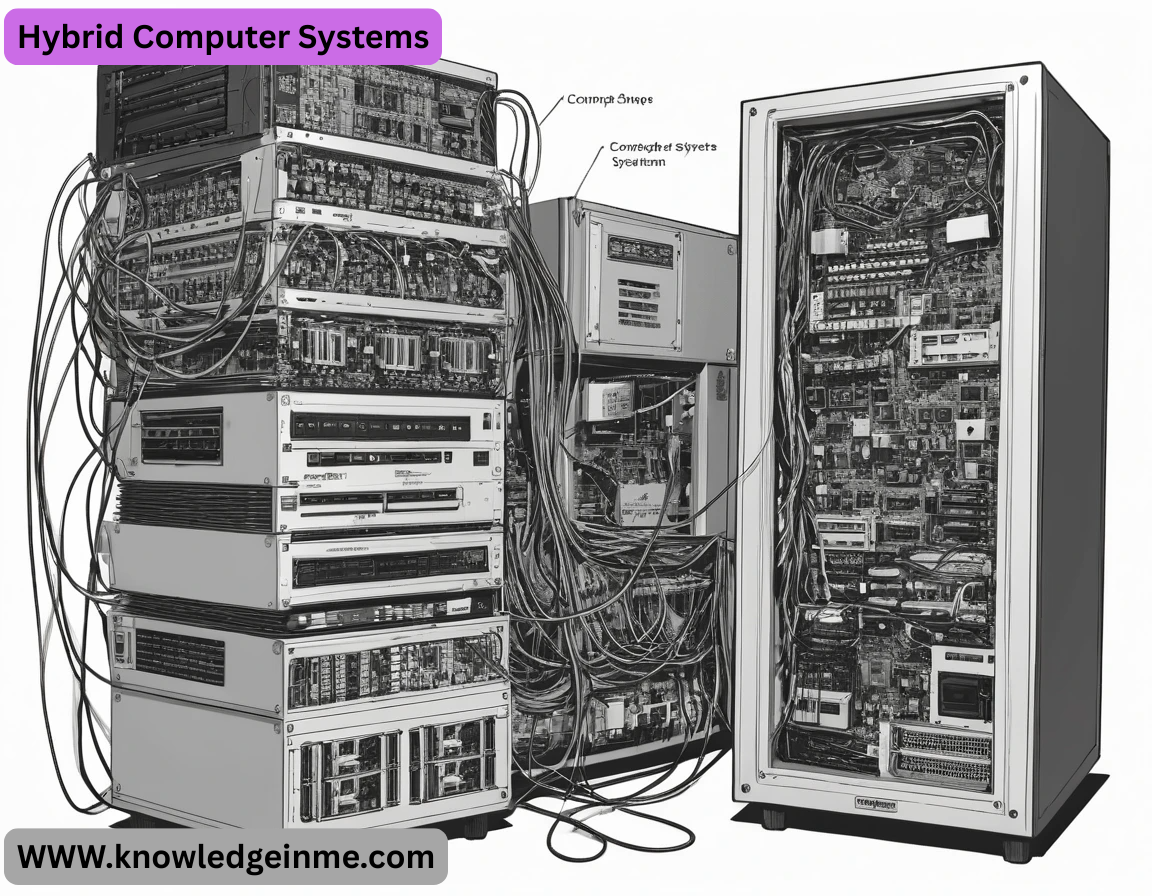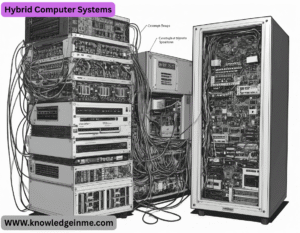Hybrid Computer Systems A hybrid computer system combines the best features of analog and digital computers to leverage their respective strengths for complex computational tasks. These systems are designed to handle both continuous (analog) and discrete (digital) data processing efficiently.
Key Features of Hybrid Computers
- Combination of Analog & Digital Processing
- Analog Component: Handles real-time, continuous data (e.g., sensor inputs, physical measurements).
- Digital Component: Manages logical operations, data storage, and high-precision calculations.
Real-Time Processing
- Ideal for applications requiring immediate feedback, such as medical monitoring or industrial control systems.
High Speed & Accuracy
- Analog systems provide fast data processing, while digital systems ensure precision in computations.
Versatility
- Can be used in scientific research, engineering simulations, and medical diagnostics.
Applications of Hybrid Computers
Medical Field
- Used in ICU monitoring systems, ECG machines, and medical imaging (e.g., MRI, CT scans).
Industrial Automation
- Controls robotic systems, process monitoring, and real-time quality checks in manufacturing.
Aerospace & Defense
- Employed in flight simulators, missile guidance systems, and satellite tracking.
Scientific Research
- Helps in weather forecasting, seismic data analysis, and nuclear simulations.
1. How Hybrid Computers Work
1.1 Analog vs. Digital vs. Hybrid Systems
Feature Analog Computers Digital Computers Hybrid Computers
Processing Speed Extremely fast (real-time) Slower (sequential processing) Fast for real-time + precise calculations
Precision Low (subject to noise) Very high High (digital compensates for analog errors)
Applications Simulations, control systems General computing, data processing Medical imaging, robotics, aerospace
1.2 Architecture of a Hybrid Computer
- A typical hybrid system consists of:
Analog Components:
- Sensors, operational amplifiers (op-amps), integrators
- Processes real-world signals (e.g., temperature, pressure)
Digital Components:
- CPU, memory, software algorithms
- Handles data storage, complex computations, and control logic
Interface (ADC & DAC):
- Analog-to-Digital Converter (ADC): Converts analog signals to digital for processing.
- Digital-to-Analog Converter (DAC): Converts digital outputs back to analog for real-world control.
2. Key Advantages of Hybrid Computers
- Real-Time Processing: Faster than digital-only systems for dynamic environments.
- High Accuracy: Digital components correct analog errors.
- Versatility: Can handle both continuous and discrete data.
- Energy Efficiency: Analog parts consume less power for certain tasks.

3. Limitations & Challenges
- Complexity: Requires specialized knowledge to design and maintain.
- Cost: More expensive than standalone analog or digital systems.
- Signal Noise: Analog components can introduce errors if not properly shielded.
4. Detailed Applications of Hybrid Computers
- 4.1 Medical & Healthcare
ECG & EEG Monitoring:
- Analog sensors capture heart/brain waves → Digital systems analyze patterns for anomalies.
Medical Imaging (MRI, CT Scans):
- Analog detectors collect signals → Digital processors reconstruct high-resolution images.
4.2 Industrial Automation & Robotics
Process Control in Factories:
- Analog sensors monitor temperature/pressure → Digital controllers adjust machinery in real time.
Robotic Arms:
- Hybrid systems enable smooth, precise movements by combining analog feedback with digital path planning.
4.3 Aerospace & Defense
Flight Simulators:
- Analog inputs mimic real flight dynamics → Digital systems generate virtual environments.
Missile Guidance Systems:
- Analog sensors track targets → Digital processors calculate trajectories.
4.4 Automotive Systems
Engine Control Units (ECUs):
- Analog sensors (oxygen, temperature) optimize fuel injection via digital logic.
Self-Driving Cars:
- Hybrid AI systems process real-time sensor data (LIDAR, cameras) for decision-making.
4.5 Scientific Research
Weather Forecasting:
- Analog models simulate atmospheric changes → Digital supercomputers refine predictions.
Nuclear Simulations:
- Hybrid computers model reactor behavior under extreme conditions.
5. Future of Hybrid Computing
AI & Machine Learning:
- Analog AI chips (e.g., neuromorphic computing) + digital neural networks.
Quantum-Hybrid Systems:
- Combining quantum computing with classical hybrid architectures.
Edge Computing:
- Hybrid Computer Systems: An In-Depth Exploration
Table of Contents
- Historical Evolution of Hybrid Computers
- Technical Deep Dive: Hybrid Architecture
- Advanced Applications & Case Studies
- Emerging Trends & Future Directions
- Design Challenges & Solutions
- Comparative Analysis with Other Computing Paradigms
- Implementation Examples & Prototypes
1. Historical Evolution of Hybrid Computers
1.1 Origins (1950s-1960s)
- First developed for military and aerospace applications (e.g., NASA’s Apollo guidance systems)
Early examples:
- EAI (Electronic Associates Inc.) HYCOMP 250 (1960s)
- Packard Bell PB-250 (used in scientific research)
1.2 Golden Age (1970s-1980s)
Widespread use in:
- Process control (chemical plants, power stations)
- Medical imaging (early CT scanners)
- Decline in the 1980s due to faster digital computers
1.3 Modern Revival (2000s-Present)
Renewed interest due to:
- Real-time AI applications
- Neuromorphic computing
- Edge computing demands
2. Technical Deep Dive: Hybrid Architecture
2.1 Core Components
Subsystem Function
Analog Front-End – Signal conditioning (amplifiers, filters) – Continuous data acquisition
Conversion Layer – High-speed ADCs/DACs (16-24 bit resolution)- Sample-and-hold circuits
Digital Back-End – FPGA/ASIC for real-time processing- CPU for complex algorithms
Control Interface – Real-time OS (e.g., QNX, VxWorks) – Hybrid programming models
2.2 Signal Processing Workflow
Analog Domain:
- Physical signals captured by sensors
- Pre-processed through op-amp circuits
Conversion:
- ADC samples at 1MSPS-1GSPS (depending on application)
Digital Domain:
- Noise reduction algorithms
- Feature extraction for AI models
Feedback Loop:
- DAC converts digital outputs to analog control signals
2.3 Key Performance Metrics
- Latency: <100μs for critical systems
- Throughput: 10^6 samples/sec (industrial applications)
- Accuracy: 0.01% error margin (medical devices)
3. Advanced Applications & Case Studies
3.1 Biomedical Engineering
- Example: Artificial Pancreas System
- Analog: Continuous glucose monitoring
- Digital: Machine learning for insulin dosage calculation
- Hybrid Advantage: Closed-loop control with <5 minute response time
3.2 Autonomous Vehicles
- Tesla’s Hybrid AI Architecture
- Analog: Radar/LIDAR signal processing
- Digital: Neural network inference
- Interface: Custom 12-bit ADCs with 2GHz sampling
3.3 Nuclear Fusion Research
ITER Tokamak Control System
- Analog: Plasma magnetic field sensors
- Digital: Predictive containment algorithms
- Challenge: 10,000+ channels processed in real-time
4. Emerging Trends & Future Directions
4.1 Neuromorphic Hybrid Systems
- Memristor-based analog neural networks
- IBM True North hybrid architecture
- Applications: Edge AI with <1W power consumption

4.2 Quantum-Hybrid Computing
- D-Wave’s quantum annealers + classical hybrid controllers
- Use Case: Optimization problems in logistics
4.3 Self-Healing Hybrid Systems
- Analog: Fault detection through impedance monitoring
- Digital: FPGA-based reconfiguration
- Example: NASA’s spacecraft avionics
5. Design Challenges & Solutions
5.1 Major Challenges
Challenge Impact Solutions
Signal Noise Accuracy degradation – Shielding – Adaptive filtering
Clock Synchronization Data corruption – PLL circuits – Jitter reduction
Thermal Drift Calibration errors – On-chip temperature sensors- Auto-
zeroing amplifiers
Component Aging Performance decay – Self-calibration algorithms
5.2 Reliability Enhancements
- Triple Modular Redundancy (TMR) for critical components
- Online Built-In Self-Test (BIST) for analog circuits
- Fault-Tolerant ADCs with error correction codes
6. Comparative Analysis
6.1 Hybrid vs. Digital vs. Analog
Criterion Analog Digital Hybrid
Speed Nanosecond Microsecond Nanosecond-Microsecond
Precision 0.1% 0.0001% 0.001%
Power Efficiency Very High Low Moderate-High
Programmability None Full Partial
6.2 When to Choose Hybrid?
- Required: Real-time processing + high accuracy
- Required: Interface with physical world + digital control
- Avoid: General-purpose computing tasks
7. Implementation Examples
7.1 Research Prototypes
- MIT’s Analog-Digital CNN Accelerator (2019)
- 10x energy efficiency vs. GPUs for image processing
- Stanford’s Hybrid Quantum Simulator (2021)
- Analog emulation of qubit interactions
7.2 Commercial Systems
Siemens S7-1500 Hybrid PLC
- Combines analog I/O with digital twin integration
- GE Healthcare Revolution CT
- Hybrid reconstruction algorithms for faster scans


